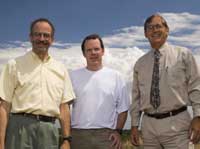The Research Angle: National Science Foundation Awards Colorado State $19 Million Science and Technology Center to Improve Cloud Modeling
 |
|
David Randall (center), Scott Denning (left) and Wayne Schubert head Colorado State's research team for the new science and technology center.
|
Scientists have struggled for decades to improve the way the clouds are represented in global atmospheric models. Since the 1960s, scientists have used such models to understand and predict future systematic changes in weather that affect the planet and particularly farmers, utilities, insurance companies and government agencies. A major, long-standing problem has been modeling the effects of clouds in a realistic way.
In July 2006 the National Science Foundation awarded Colorado State University and its partners a $19 million Science and Technology Center to build a radically new kind of global atmospheric model that will more realistically depict cloud processes.
The NSF Science and Technology Center for Multi-Scale Modeling of Atmospheric Processes will be based at Colorado State in the College of Engineering's renowned Department of Atmospheric Science.
Even with very large, complex computers, scientists working on climate modeling struggle to represent the physical and chemical processes of clouds, including precipitation, strong cloud-scale motions and radiation. It has been especially difficult to realistically simulate the interactions between cloud systems and the global-scale circulation of the atmosphere.
The prototype model developed at Colorado State uses a high-resolution model to simulate the populations of clouds in each of the thousands of "grid columns" of a global atmospheric model. The cloud model represents a sample of the clouds in each grid column. This new approach has only recently become possible because of the increasing speed of computers.
The new model will make it possible to produce more robust simulations of both next week's weather and future climate change. The work of the modeling center will have a wide range of impacts on both science and society because it will increase our understanding of climate processes and our ability to make reliable simulations of cloud processes as they relate to both climate change and weather prediction.